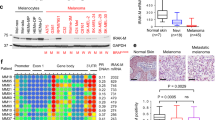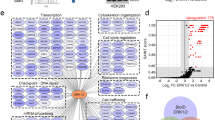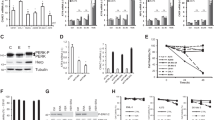Abstract
Radiation resistance is a hallmark of human melanoma, and yet mechanisms underlying this resistance are not well understood. We recently established the role of ATF2 in this process, suggesting that stress kinases, which contribute to regulation of ATF2 stability and activity, play an important role in the acquisition of such resistance. Here we demonstrate that changes in the expression and respective activities of TRAF2/GCK occur during melanoma development and regulate its sensitivity to UV-induced apoptosis. Comparing early- and late-stage melanoma cells revealed low expression of TRAF2 and GCK in early-stage melanoma, which coincided with poor resistance to UV-induced, TNF-mediated apoptosis; forced expression of GCK alone or in combination with TRAF2 efficiently increased JNK and NF-κB activities, which coincided with increased protection against apoptosis. Conversely, forced expression of the dominant negative form of TRAF2 or GCK in late-stage melanoma cells reduced NF-κB activity and decreased Fas expression, resulting in a lower degree of UV-induced, Fas-mediated cell death. Our results illustrate a mechanism in which protection from, or promotion of, UV-induced melanoma cell death depends on the nature of the apoptotic cascade (TNF or Fas) and on the availability of TRAF2/GCK, whose expression increases during melanoma progression.
This is a preview of subscription content, access via your institution
Access options
Subscribe to this journal
Receive 50 print issues and online access
$259.00 per year
only $5.18 per issue
Buy this article
- Purchase on Springer Link
- Instant access to full article PDF
Prices may be subject to local taxes which are calculated during checkout






Similar content being viewed by others
Abbreviations
- FasL:
-
Fas ligand
- TRAF2:
-
tumor receptor associated factor 2
- GCK:
-
germinal center kinase
- UVC:
-
ultraviolet light C
- AP1:
-
activator protein 1
- RIP:
-
receptor interacting protein
- NIK:
-
NF-κB-inducing kinase
- HOS:
-
human homologue of Slimb
- IAP:
-
inhibitory apoptosis proteins
- JNK:
-
Jun amino terminal kinase
- TNFR1:
-
tumor necrosis factor receptor 1
- TCF:
-
ternary complex factor
- CREB:
-
Cyclic AMP responsive element binding protein
- CHX:
-
cycloheximide
- EMSA:
-
electrophoretic mobility shift assay
References
Adams JM and Cory S. . 1998 Science 281: 1322–1326.
Arch RH, Gedrich RW and Thompson CB. . 1998 Genes Dev. 12: 2821–2830.
Ashkenazi A and Dixit VM. . 1998 Science 281: 1305–1308.
Bakker TR, Reed D, Renno T, Jongeneel CV. . 1999 Int. J. Cancer 80: 320–323.
Baldwin Jr AS. . 1996 Annu. Rev. Immunol. 14: 649–681.
Brenner B, Koppenhoefer U, Weinstock C, Linderkamp O, Lang F and Gulbins E. . 1997 J. Biol. Chem. 272: 22173–22181.
Brockman JA, Scherer DC, McKinsey TA, Hall SM, Qi X, Lee WY and Ballard DW. . 1995 Mol. Cell. Biol. 15: 2809–2818.
Carpentier I, Declercq W, Malinin NL, Wallach D, Fiers W and Beyaert R. . 1998 FEBS Lett. 425: 195–198.
Chan H, Bartos DP and Owen-Schaub LB. . 1999 Mol. Cell. Biol. 19: 2098–2108.
Chaudhuri A, Orme S, Vo T, Wang W and Cherayil BJ. . 1999 Biochem. Biophys. Res. Commun. 256: 620–625.
Deak J, Cross J, Lewis M, Qian Y, Parrott L, Distelhorst C and Templeton D. . 1998 Proc. Natl. Acad. Sci. USA 85: 5595–6000.
Deveraux Q and Reed JC. . 1999 Genes & Dev. 13: 239–252.
Faris M, Kokot N, Latinis K, Kasibhatla S, Green DR, Koretzky GA and Nel A. . 1998 J. Immunol. 160: 134–144.
Faris M, Latinis KM, Kempiak SJ, Koretzky GA and Nel A. . 1998b Mol. Cell. Biol. 18: 5414–5424.
Fuchs SY, Adler V, Pincus MR and Ronai Z. . 1998 Proc. Natl. Acad. Sci. USA 95: 10541–10546.
Fuchs SY, Chen A, Xiong Y, Pan Z-Q and Ronai Z. . 1999 Oncogene 18: 2039–2046.
Galibert L, Tometsko ME, Anderson DM, Cosman D and Dougall WC. . 1998 J. Biol. Chem. 273: 34120–34127.
Goillot E, Raingeaud J, Ranger A, Tepper RI, Davis RJ, Harlow E and Sanchez I. . 1997 Proc. Natl. Acad. Sci. USA 94: 3302–3307.
Huang C, Ma WY, Maxiner A, Sun Y and Dong Z. . 1999 J. Biol. Chem. 274: 12229–12235.
Hsu H, Shu H-B, Pan M-G and Goeddel DV. . 1996 Cell 84: 299–308.
Ip YT and Davis RJ. . 1998 Curr. Opin. Cell Biol. 10: 205–219.
Ivanov VN, Deng G, Podack ER and Malek TR. . 1995 Internatl. Immunol. 7: 1709–1720.
Ivanov VN and Ronai Z. . 1999 J. Biol. Chem. 274: 14079–14089.
Kasibhatla S, Brunner T, Genestier L, Echeverri F, Mahboubi A and Green DR. . 1998 Mol. Cell. 1: 543–551.
Kelliher MA, Grimm S, Ishida Y, Kuo F, Stanger BZ and Leder P. . 1998 Immunity 8: 297–303.
Kyriakis JM. . 1999 J. Biol. Chem. 274: 5259–5262.
Lee F, Peters R, Dang L and Maniatis T. . 1998 Proc. Natl. Acad. Sci. USA 95: 9319–9324.
Lee SY, Reichlin A, Santana A, Sokol KA, Nussenzweig MC and Choi Y. . 1997 Immunity 7: 703–713.
Levine AJ. . 1997 Cell 88: 323–331.
Lin X, Mu Y, Cunningham ET, Marcu KB, Geleziunas R and Green WC. . 1998 Mol. & Cell. Biol. 18: 5899–5907.
Liu Z-G, Hsu H, Goeddel DV and Karin M. . 1996 Cell 87: 565–576.
Malinin NL, Boldin M, Kovalenko A and Wallach D. . 1997 Nature 385: 540–544.
Maniatis T. . 1999 Genes Dev. 13: 505–510.
Meier F, Satyamoorthy K, Nesbit M, Hsu M-Y, Schittek B, Garbe C and Herlyn M. . 1998 Frontiers in Bioscience 3: 1005–1010.
Minden A and Karin M. . 1997 Biochim. Biophys. Acta. 1333: F85–F104.
Moretti S, Pinzi C, Spallazani A, Berti E, Chiarugi A, Mazzoli S, Fabiani M, Vallecchi C and Herlyn M. . 1999 Int. J. Cancer 20: 160–168.
Nagata S. . 1997 Cell 88: 355–365.
Natoli G, Costanzo A, Ianni A, Templeton DJ, Woodgett JR, Balsano C and Levrero M. . 1997 Science 275: 200–203.
Natoli G, Costanzo A, Guido F, Moretti F, Bernardo A, Burgio VL, Agresti C and Levrero M. . 1998a J. Biol. Chem. 273: 31262–31272.
Natoli G, Costanzo A, Guido F, Moretti F and Levrero M. . 1998b Pharmacol. 56: 915–920.
Nicoletti I, Migliorati G, Pagliacci MC, Grignani F and Riccardi C. . 1991 J. Immunol. Methods 139: 271–279.
Nishitoh H, Saitoh M, Mochida Y, Takeda K, Nakano H, Rothe M, Miyazono K and Ichijo H. . 1998 Mol. Cell. 2: 389–395.
Peli J, Schroter M, Rudaz C, Hahne M, Meyer C, Reichmann E and Tschopp J. . 1999 EMBO J. 18: 1824–1831.
Reinhard C, Shamoon B, Shyamala V and Williams LT. . 1997 EMBO J. 16: 1080–1092.
Relaix F, Wei X-J, Wu X and Sassoon DA. . 1998 Nature Genetics 18: 287–291.
Ronai Z, Yang Y-M, Fuchs SY, Adler V, Sardana M and Herlyn M. . 1998 Oncogene 16: 523–531.
Satyamoorthy K, DeJesus E, Linnenbach AJ, Kraj B, Kornreich DL, Rendle S, Elder DE and Herlyn M. . 1997 Melanoma Res. Suppl. 1: S35–S42.
Shi CS and Kehrl JH. . 1997 J. Biol. Chem. 272: 32102–32107.
Shi CS, Leonardi A, Kyriakis J, Siebenlist U and Kehrl JH. . 1999 J. Immunol. 163: 279–285.
Song HY, Regnier CH, Kirschning CJ, Goeddel DV and Rothe M. . 1997 Proc. Natl. Acad. Sci. USA 94: 9792–9796.
Sprecher E, Bergman R, Meilick A, Kerner H, Manov L, Reiter I, Shafer Y, Maor G and Friedman-Birnbaum R. . 1999 J. Cutan. Pathol. 26: 72–77.
Tan P, Fuchs SY, Chen A, Wu K, Gomez C, Ronai Z and Pan Z-Q. . 1999 Mol. Cell. 3: 527–533.
Thornberry NA and Lazebnik Y. . 1998 Science 281: 1312–1316.
Ting A, Pimentel-Munos FX and Seed B. . 1996 EMBO J. 15: 6189–6196.
Tobin D, van Hogerlinden M and Toftgard R. . 1998 Proc. Natl. Acad. Sci. USA 95: 565–569.
van Dam H, Huguier S, Kooistra K, Baguet J, Vial E, van der Eb AJ, Herrlich P, Angel P and Castellazzi M. . 1998 Genes Dev. 12: 1227–1239.
Yang X, Khosravi-Far R, Chang HY and Baltimore D. . 1997 Cell 89: 1067–1076.
Yang Y-M, Dolan L and Ronai Z. . 1996 Oncogene 12: 2223–2233.
Yeh W, Shahinian A, Speiser D, Kraunus J, Billia F, Wakeham A, de la Pompa J, Ferrick D, Hum B, Iscove N, Ohashi P, Rothe M, Goeddel DV and Mark TW. . 1997 Immunity 7: 715–725.
Yuasa T, Ohno S, Kehrl JH and Kyriakis JM. . 1998 J. Biol. Chem. 273: 22681–22692.
Zandi E, Rothwarf DM, Delhase M, Hayakawa M and Karin M. . 1997 Cell 91: 243–252.
Acknowledgements
We thank Drs van Dam, DA Sassoon, JS Economou, D Ballard, M Karin, JM Kyriakis and R Davis for providing expression vectors, Dr M Herlyn for LU1205, WM1552 and WM1650 melanoma cells, Ø Fodstad for HHMSX, FEMX and THX melanoma cells and M Green for NEB for phosphoantibodies. We also thank SY Fuchs for discussion and Dania Alarcon-Vargas for editorial comments. Support from the National Cancer Institute through grant CA 51995 (to Z Ronai) is gratefully acknowledged.
Author information
Authors and Affiliations
Rights and permissions
About this article
Cite this article
Ivanov, V., Kehrl, J. & Ronai, Z. Role of TRAF2/GCK in melanoma sensitivity to UV-induced apoptosis. Oncogene 19, 933–942 (2000). https://doi.org/10.1038/sj.onc.1203415
Received:
Revised:
Accepted:
Published:
Issue Date:
DOI: https://doi.org/10.1038/sj.onc.1203415
Keywords
This article is cited by
-
The TRAF2-p62 axis promotes proliferation and survival of liver cancer by activating mTORC1 pathway
Cell Death & Differentiation (2023)
-
The mycobacterial phosphatase PtpA regulates the expression of host genes and promotes cell proliferation
Nature Communications (2017)
-
Silencing of Apoptosis-Inducing factor and poly (ADP-ribose) glycohydrolase reveals novel roles in breast cancer cell death after chemotherapy
Molecular Cancer (2012)
-
Death receptors and melanoma resistance to apoptosis
Oncogene (2003)
-
A translationally regulated Tousled kinase phosphorylates histone H3 and confers radioresistance when overexpressed
Oncogene (2001)



